ANCIENT AND NEW MENORAHS
The menorah is the golden seven-armed lampstand, whose construction is described in the Bible (Exodus 25). Not man, but God personally has determined the construction. Nobody knows exactly how the Menorah described in the Book of Exodus may have looked. And nobody knows how the 22 almond blossoms were arranged exactly and what the foot of the menorah looked like. There are a lot of ideas. This reminds us of the biblical saying of 1Cor 13:12: "For now we see only a reflection as in a mirror; then we shall see face to face. Now I know in part; then I shall know fully, even as I am fully known." However, over the course of several thousand years people have changed the form. The Biblical Menorah has 7 oil lamps but not 7 candles. "Contrary to some modern designs, the ancient menorah did not contain anything resembling seven candles, as candles were unknown in the Middle East until about 400 CE" (Wikipedia). The menorah pictures found in different places are also proof that the ancestors of today's Israelis have lived in these areas for a long time. According to the Jewish belief, no illustrations of objects were allowed to be made. Exodus 20:3-7 is very clear at this point. This is the reason why we can not find more menorah pictures from earlier times. This is also the reason why similar but not entirely accurate menorah representations have been made in order not to break the law of God. In other words: The new style of the menorah should demonstrate that this means not the Temple menorah, which was in sacral seclusion. The Babylonian Talmud allowed the 7-armed menorah only in the temple, therefore Menoras with 5 to 11 arms were also depicted privately. Over the centuries, the menorah became a symbol of the Jewish identity of the Jews scattered throughout the world (Diaspora). But also Christians and even Muslims (see info in the 7th -8th century) liked to use this seven-armed symbol. It is a symbol that connects the religions, because it stands for the light of God (the Bible) in this dark world, which shows us the way to love and to God.
Historical Menorah Images from all Centuries

Part 1: The oldest items: Ancient Menorahs - BC / BCE
The Bible says: "Now the Lord God had planted a garden in the east, in Eden; and there he put the man he had formed. The Lord God made all kinds of trees grow out of the ground - trees that were pleasing to the eye and good for food. In the middle of the garden were (1.) the TREE OF LIFE and (2.) the TREE OF KNOWLEDGE OF GOOD AND EVIL" (Genesis 2:8-9). No one knows how the "Tree of Life" described in the Bible looked. But numerous representations in various cultures suggest that the shape was similar to the Menorah. The look or shape of the "Tree of Life" was passed on orally from generation to generation. However, the origin of the Menorah has nothing to do with the ancient Mesopotamian "Tree of Life" (or "World Tree") of the Sumerians, Babylonians and Persians, but the form has been determined by God (Exodus 25). He was the one who created the "Tree of Life" and shaped the Menorah. He was the first one. The "Tree of Life" is mentioned in the first and last book of the Bible (Gen 2:9; 3:22; Rev 2:7, 22:2). There is a close connection with the "Book of Life." The shape of the "Tree of Life" and the Menorah has been changed over and over again in the course of history by the individual cultures. Some cultures have copied the symbols of the people of God and then realized their own ideas. The Samaritans, too, have reinterpreted God's symbols in their own way. They represented the Menorah along with pagan symbols. Some cultures have built pictures of the "Tree of knowledge of the good and evil" and not of the "Tree of Life." We have to differentiate and look carefully because THERE ARE TWO DIFFERENT TREES with two different ways of life. And we always have to pay attention: THERE ARE DIFFERENT MENORAHS, the biblical and many other modified forms of many various political, masonic and religious groups. The particular light always has a different meaning and is used for worship for different gods. Of course, the "Tree of Life" and the Menorah has nothing to do with the Christmas tree, as some pastors falsely teach, in order to enhance this festival with pagan roots. The Christmas tree symbolizes much more the "Tree of knowledge of the good and evil" (where everyone can have their own religion and "the beautiful solemn tradition"), although some confuse him with the "Tree of Life." It has an other light. The inconvenient truth for many pastors is: The first Christian church has not celebrated a single Christmas. And as soon as Jesus returns to earth, there will be no Christmas (and no Christmas tree) in all eternity. The symbolism of evergreen trees (which often look similar to the Menorah) has much earlier origins that can be traced to the worship of the Sun God Mithras around 600 BC (see image below). The Bible teaches other celebrations that the world does not want to pay attention to. Everything passes away, but the true "Tree of Life" (the symbol of the "Book of Life") and the Menorah will always exist.

4000 BC (or older). Mesopotamia. Archaeologists have unearthed vessels portraying “Tree of Life” motifs during excavation works in the Domuztepe Mound (Kahramanmaras, Turkey). Archaeologists had seen figures of pine trees on some vases and potteries and that it is very interesting and important “since it is not an ordinary tree. It is related to a faith system, a burial tradition." The oldest known example of this tree’s culture or belief system is in Domuztepe. Link1, Link2

Before 3000 BC. A Tree of Life on a Mesopotamian stone vase. Redrawn from Figure 67 in Roger Cook: "The Tree of Life: Image for the Cosmos", Thames and Hudson, New York, 1974, page 119. This illustration is similar to the construction of the Menorah. Source: Link1, Link2

2000-1850 BC. A figure stands before a sacred tree in a scene of reverence. In Babylonian mythology, the Tree of Life was a magical tree that grew in the center of paradise. The Apsu, or primordial waters, flowed from its roots. It is the prototype of the tree described in Genesis, an ancient symbol from which the Egyptian, Islamic, and Kabbalistic Tree of Life concepts originated. The tree of life can also represent the spine and branches of the human nervous system. Source: Link

Before 1400 BC? Dr. Kim discovered this ancient Menorah (golden lampstand) rock inscription at in Saudi Arabia, which is about 120-130 kilometers from Mount Sinai. It is likely the oldest rock inscription of a Menorah in the world having been inscribed by the Israelits as they wandered in the wilderness of Midian. Source: Link

1200-600 BC. Assyrian tree of life. This Assyrian relief is from the throne room of the North-West Palace of Ashurnasirpal II (reigned 883-859 BC) at Nimrud in northern Iraq. The king appears twice, shown from two sides, dressed in ritual robes and holding a mace symbolising his authority. The figure of the king on the right makes a gesture of worship to a god in a winged disk in the top center of the relief. He is blessed by protective spirits. Source: Link1, Link2, Link3, Link4, Link5

911-605 BC. Assyrian Tree of Life. Cylinder seal with the solar disk of Ashur, anointing with two eagle-headed gods before the Tree of Life. The sacred tree was an extremely important symbol in the palace of Ashurnasirpal, appearing on reliefs in virtually every room of the palace. It was also used in textile patterns, on stamp and cylinder seals, and in ivory carvings. It represented both the king and Ashur, the chief god of Assyria, and was also a symbol of the fertility of the land. Source: Link1, Link2

865-860 BC. Neo-Assyrian era. A pair of Apkallu with Sacred Tree of Life. These reliefs demonstrate human-headed and bird-headed Apkallu (means 'sage' in Akkadian). An Apkallu was a protective spirit which protected the king. In several contexts the Apkallu are seven demi-gods, sometimes described as part-man and part eagle or fish. Wall Reliefs, North West Palace of Ashurnasirpal II. Palace at Nimrud (ancient Kalhu), Mesopotamia, Iraq. The British Museum, London. Link1, Link2, Link3

7th century BC. Wall relief from Babylon. Protective spirit and the Tree of Life. The Babylonian Tree of Life had a different form from that mentioned in the Bible. He also has no direct connection to the form of the Menorah. But he was considered a role model for the later Christmas trees in many countries. Source: Link

2nd-1st century BC. Judaic Stone Architectural Frieze with menorah. A carved rectangular architectural panel with frieze of running tetragammadion motifs with rosettes, to the centre a menorah with a ring and pellet above. 15 kg, 225 cm (88"). The menorah in the middle of the stone has the shape of a "Tree of Life." LiveAuctioneers Lot 0680. Source: Link

2nd-1st century BC. The ancient synagogue in Çatiören (an archaeological site in Cilicia, Mersin Province, Turkey), which Dr. Fairchild discovered in the spring of 2007, more than likely dates back to the Hellenistic Period, based on the polygonal masonry and a nearby inscription. If this proves to be true, it would be the earliest synagogue ever discovered. Menorah carved into the doorway lintel, and a lulav (palm branch) on the right side. Source: Link1, Link2, Link3, Link4, Link5, Link6

1st c. BC. Relief carving at Persepolis, Iran. Ceremonial capital of the Achaemenid Empire, depicting Mithra and an evergreen tree. In the first few centuries, Christians did not feast on Christmas and did not have a Christmas tree, as all this came from paganism. The symbolism of evergreen trees has much earlier origins that can be traced to the worship of the Sun God Mithras around 600 BC, as Mithras was often pictured in an evergreen tree or next to one. Source: Link1, Link2, Link3

1st century BC. Tree of Life Bas-reliefs of the Apadana Palace, Persian Persepolis, Iran (The origin of the Christmas tree). The panels showing 23 delegations bringing their tributes to the Achaemenid king. This rich record of the nations of the time ranges from the Ethiopians in the bottom left center, through a climbing pantheon of, among other peoples, Arabs, Thracians, Indians, Parthians and Cappadocians, up to the Elamites and Medians at the top right. Source: Link

1st century BC - 2nd century AD. This ancient ring made of bronze, has two menorahs one on each side, the bezel engraved with a Syraic or aramaic script. Dimensions: Diam. 19 mms. bezel size, 10 mms. Provenance: Ex- American private collection, acquired in the 1960s. LiveAuctioneers 2016, Lot 0067. Source: Link

1st century BC or later. Near Eastern Glass Menorah Weight. A discoid weight with stamped motif of the menorah. 6.48 grams, 28 mm (1"). Property of a London gentleman; acquired before 1980. TimeLine Auctions Ltd; LiveAuctioneers, Lot 0286. Source: Link

100 BC to 100 AD. Ancient second temple period lead bulla depicting a menorah. The bullae was used as a voucher originally attached to strings that once wrapped a document or letter. Then it was often broken and discarded, once the document was opened. The impression of a seal, preserved on a bullae suggest that the seal functioned as validation of documents, and as a guarantee of exchanged goods and services. Origin: Israel. Location: United States. Source: Link, Link2

1st century BC-1st century AD. Roman Pendant with Jewish Menorah. A triangular lead pendant with stamped image to the obverse, menorah within a beaded border. 21.4 grams, 26mm (1"). Property of a Brussels collector; formerly in an old German collection formed in the 1990s. LiveAuctioneers Lot 1495, 2019. Source: Link

1st millennium BC. Jewish Lead Seal with Menorah. A plano-convex lead seal with impressed menorah to the flat face. 8.4 grams, 16mm (1/2"). Property of a gentleman; from a Mayfair, London, UK, gallery; formerly in a 1990s UK collection. LiveAuctioneers Lot 1029, 2019. Source: Link

1st century BC - 1st century AD. Ancient lead seal menorah, 24.11 gm, 25 mm; seven branch’s Menorah, two Hebrew letters MEM NUN, below the menorah srounded by pearl square, scorpion on the other side, stunning details. Dark brown patina. VCoins. Source: Link

1st century BC - 1st century AD? Ancient Jewish lead seal with a menorah. Seven-branched menorah / Blank. 9mm, 1.96 grams. Source: Link

100 BC. Jason’s tomb (Kever Yason) is is a Jewish rock-cut tomb in Jerusalem. It was built in a Greek architecture manner by the Hasmoneans. The graffiti includes depictions of stags, five seven-branched menorahs, and three ships with sails. Jason became High Priest in 175 BCE. Josephus records that his name, before he hellenised it, was originally Jesus (Hebrew Yeshua). Illustration from the book: „Ancient Jewish Art and Archaeology in the Land of Israel” by Rahel Haklili. Source: Link1, Link2

50 BC to 300 AD. Rectangular decorated slab. Untypical form of the menorah (?), but in an artistic work. Origin: Mediterranean. Location: Great Britain. Source: Link

40-37 BC. Prutah of King Mattathias Antigonus. Place Made: Jerusalem. Bronze coin. Diameter: 9/16 in. (1.4 cm). This coin bears an image of the table of showbread and an image of the menorah, the seven-branched lampstand that stood in the Temple of Jerusalem until the building was destroyed in 70 CE. This is one of the rare depictions of the menorah to have been made while the Temple was still standing. The Jewish Museum, New York. Source: Link

40-37 BC. Coin of Mattathias Antigonus, the Hasmonean; King of Judea; obverse: Table of shewbread; reverse: menorah and Greek inscription 'Basileus Antignus' (King Antignus). Independence from Roman rule (as the Hasmoneans served as high priests and kings). The menorahs on these coins and those incised on the walls of Jason's Tomb are the earliest surviving depictions of the seven-branched lampstand used in the Jerusalem Temple. Center for Jewish Art. Source: Link1, Link2, Link3

40-37 BC. Coin of Antigonus. A Greek name meaning “comparable to his father” or “worthy of his father”. In this context, we are referring to Antigonus (died 37 BC), the last ruler of the Hasmonean kingdom of Judea. This is known as the, “Coin of Antigonus”. © 2017 Center for Online Judaic Studies. Source: Link

40-37 BC. Ancient copper alloy coin. Seven branched candelabra (Menorah). Greek Inscription Content: [ΒΑΣΙΛ]ΕΩΣ ΑΝΤ[ΙΓΟΝΟY], Transliteration: BASILEOS ANTIGONOU, Translation: King Antigonus, Ruler: Mattathias Antigonus. Obverse: Showbread table with four legs, traces of inscription around. Minted in Judaea. Weight: 1.85 grams. The British Library, number 1888,0512.29. Source: Link

40-37 BC. Judaea, Hasmonean Kingdom. Mattathias Antigonos (Mattatayah). Æ Prutah (1.60 g), Jerusalem. Trace of ‘Mattatayah the High Priest’ (Paleo-Hebrew), showbread table. Reverse: [BA]SILE[WS ANTIGONOU] and seven-branched menorah. (TJC 42; Hendin 1168). A great rarity and the only ancient Jewish coin depicting the menorah. The New York Sale. Source: Link

40-37 BC. Antigonus coin before and after the restoration (cleaning). Fontanille Coins. Source: Link

40-37 BC. Coin of Antigonus. Important Jewish Bronze AE Prutah (14mm). The only Jewish issue of coinage to depict objects used in Temple worship. During the Second Temple period, depictions of these, the most sacred vessels within the Temple, were prohibited. The showbread table, consisting of a flat board supported by four legs. Reverse: The Temple menorah. Ira & Larry Goldberg Coins & Collectibles, Sale 41. Lot 2396. Source: Link

40-37 BC. Priest: Antigonus II Mattathias, Hebrew: Matityahu, also known as Antigonus the Hasmonean, was the last Hasmonean king of Judea. Jerusalem. Material: Perutah. Front: showbread table; Paleo-Hebrew: MTTYH KHN GDL (Mattityah, the High Priest). Back: Menorah; Greek: ΒΑΣΙΛΕΩΣ ANTIΓONOY (coin of King Antigonos). Diameter: 16.7 mm. Weight: 1.66 g. Kunsthistorisches Museum Wien, Israel Museum Jerusalem. Link

40-37 BC. Antigonus. Prutah, 1.26g. Obv: Mattatayah the High Priest around showbread table. Rx: BAΣΙΛΕΩΣ ΑΝΤΙΓΟΝΟΥ; menorah. Other than the first type of the Year One Shekel of the Jewish War, the menorah coin of Antigonus is the most significant and sought-after of all Jewish coins. At the time that this coin was minted the golden show-bread table was considered more relevant than the menorah, which is why it is on the obverse. Gemini Numismatic Auctions XI, Lot 294. Link, Link2

40-37 BC. Coin of Antigonus. This coin represents what it probably the most important type in Jewish numismatics. During the Second Temple period, depictions of these most sacred of artefacts were prohibited, thus their appearance on this coinage was both unprecedented and extremely significant. Source: Link

40-37 BC. Ancient menorah coin, Mattatayah Antigonus (40 - 37 BC). AE prutah (15.9 mm, 1.54 gm, 12h). Traces of paleo-Hebrew Text "Mattatayah the Priest" (translated) around showbread table. Reverse: BAΣIΛEΩΣ ANTIΓONOY (translated: King Antigonus) and seven-branched menorah. Image by Heritage Auctions, HA.com, LOT #20057. Source: Link

40-37 BC. Coin of Mattityah Antigonos. Coined in honour of King Mattathias Antigonos, the last of the Chashmonean kings, who ruled some 100 years before the destruction of the 2nd Holy Temple. On obverse the showbread table used in the Temple is depicted, Trace of 'Mattatayah the High Priest', showbread table. Rev: BASILEOS ANTIGONOY, seven-branched menorah. Source: Link1, Link2, Link3, Link4

40-37 BC. Ancient coin minted by Mattathias Antigonus, the last King of the Hasmonean Dynasty. This ancient coin was used by Jews who lived in the land of Israel hundreds of years before the
advent of Islam to Arabia and the immigration of Islamo-Arabs to the land of Israel. Source: Link1, Link2, Link3

1st century BCE to 70 AD. Pflaster These two fragments of unpainted plaster were found in the debris of one of the Herodian period homes in the Jewish Quarter of Jerusalem. However, the number of individual parts does not correspond to the information in the Bible. Current Location: Israel Museum, Jerusalem. Source: Link1, Link2, Link3, Link4, Link5, Link6, Link7

100 BC-100 AD. 'Go Big' Hebrew Oil Lamp. Normally, Jews were not allowed to create any illustrations of objects. This is the reason why we can not find more pictures from earlier times. Over the centuries, arts have been created as a sign of national identity in the Jewish diaspora. Source: Link

100 BC-200 AD. Ancient Holy land clay with menorah. Nice decoration and patina, intact .Size : 9 cm x 5.5 cm. LiveAuctioneers, Lot 0001. Source: Link

1st century BC - 1st century AD. Ancient Roman Terracotta mold formed oil lamp with a menorah on top. Intact. Size : 9.2 cm x 6.3 cm. Provenance: Ex-private NY collector. Source: Link
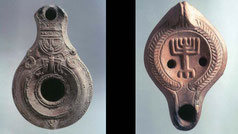
BCE - 9th CE. Image from the book: "Haneroth Halalou", by Chaim Kaufman & Robert Deutsch, 2012 (288 pages, 1040 BW pictures, 34 color pictures). The book presents the largest private collection of Jewish oil lamps recorded to date. Including 1034 items and 91 oil lamps with menorah. It is the most important collection of jewish oil lamps recorded to date. The collection of Josef Chaim Kaufman. Source: Link
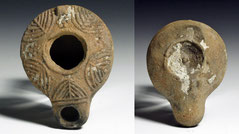
1st century BC - 1st century AD. Terracotta mold formed oil lamp with menorahs on top. Small handle and extended spout. Burn marks around spout. Circular base with center divit. 3-1/4"L. LiveAuctioneers, Lot 0126. Source: Link

1st century BC - 1st century AD. An early Jewish limestone ossuary. Roman Period. The hollow rectangular box on four low feet, the front and right sides red-slipped, the front engraved with an abstract design composed of zigzag lines, including three distinct menorot, the large central menorah seven-branched, with straight arms and a tripod base, a five-branched menorah on each side with curving arms, angled toward the center, all within a border. 14½ in. (36.8 cm.) wide. Christie's. Source: Link

1st century BC - 1st century AD. Ancient Judaean carved limestone relief with menorah. Imposing piece of ancient Judaica. Size: 44cm x 33cm x 13cm. Live-Auctioneers. Lot 0175. Source: Link

1st century BC - 1st century AD. Ancient Roman Judaean Basalt synagogue lintel with menorah. Symbols of the seven-branched menorah stand for Light, exceptional and imposing piece of ancient Judaean provenance: NY collection Ex NJ Auction. Height: 13.25in, width: 20.5in, thickness: 3.9in. Anders Auction. Source: Link1, Link2

1st century BC - 1st century AD. Ancient Roman Judaean basalt synagogue Lintel with seven-armed menorah. Length: 16in, Width: 11in, Thickness: 3.5in, Weight: 41lbs. Provenance: NY Collection Ex NJ Auction. Source: Link

1st century BC - 1st century AD (?). Ancient Judaic carved stone slab with Menorah; unmarked. Dimensions: 15"L x 9"W. LiveAuctioneers 2012, Lot 0353. Source: Link

1st century BC - 1st century AD. Holy Land Judaic carved stone relief with menorah. Exceptional and imposing piece of ancient Judaica. Size: 33cm x 25 cm x 10 cm. Provenance: private NY collection. LiveAuctioneers, Lot 0123. Source: Link

1st century BC-1st century AD? An undated archaistic rectangular bronze plaque in 1st century BC-1st century AD style, with raised border, low-relief menorah between rosettes, hole to each angle. 88 grams, 66mm (2 1/4"). LiveAuctioneers. Lot 0355. Source: Link
Ancient Menorahs - 1st Century AD / CE

1st-3rd century. Roman Period Jewish Mezuzah. The Hebrew amulet called a Mezuzah is decorated with a raised menorah and an attached suspension loop. Weight: 4.2. Length: 25 mm. Goldbergcoins, Sale 79, Lot 707. Source: Link
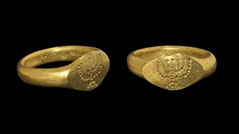
1st century. A gold finger ring with D-section hoop expanding to an elliptical bezel bearing a punched-point design of a seven-line candelabra. Gold, 4.74 grams, 17 mm overall (approximate size British G 1/2, USA 3 1/2, Europe 5.55, Japan 5). Live-Auctioneers 2011, Lot 0144. Source: Link

1st-2nd century AD. Roman Pendant with Jewish Menorah. A ceramic disc pendant with low-relief menorah motif. 27.3 grams, 60mm (2 1/4"). From a private Belgian collection; previously part of a private collection formed in Germany in the 1990s. LiveAuctioneers, Lot 1253; 2019. Source: Link

1st-3rd century AD. A bronze pendant with seven-armed menorah to each flat face, radiating lobes to the rim and pierced lugs above. 4 grams, 23 mm (1"). Property of a London gentleman; acquired by his father in the 1970s; thence by descent. LiveAuctioneers 2019, Lot 1049. Source: Link

1st-4th century AD. Roman gemstone with menorah. A circular iron pendant or mount with inset stone intaglio engraved with menorah; small loop with rod to the top and lug to the lower rim. 3.38 grams, 23mm (1"). Liveauctioneers Lot 1345 2019. Source: Link

40-50 AD. Oil lamp Judaica Roman, in bronze with a menorah reflector, black patina, green crust Approaching the type 4E/F 1st century AD, around 40/50 AD with defect. Second known example of this type, judaica rare object preceding the 4th century AD. Size: 22CM x 8.5CM. Source: Link

1st century, before 60 AD. Ancient menorah carved in stone from Yofat (Jotapata, Israel). This village was destroyed by the Romans in 60 AD. The commander of the Jewish Resistance in Galilee was Yosef Bar Mattityahu. He escaped Yotfat's slaughter and became a Roman historian with his new name Flavius Josephus. His four books became world famous and, like the NT, were written in Greek. Source: Link

66 AD. A rare Roman sword from a Roman soldier and an engraving of a 5-arming Menorah on a piece of stone were found in the 2000 year old drainage system in Jerusalem which ran between the City of David and the Jerusalem Archaeological Garden. Archaeologists assume that this menorah was engraved by a child. Photo S. Schreiner. Source: Link1, Link2, Link3

Before 70 AD. This tiny stone sundial (only 2″ wide by 2″ high) may be the only known surviving artifact from the Temple of King Herod. It was found during excavation of a pile of debris attributed to the destruction of the Temple. Perhaps it was used by the temple priests to ascertain their time of service at the Temple. Source: Link

Before 70 AD. Temple sundial. This limestone sundial is the only known surviving artifact from King Herod's Temple. Found during the late Benjamin Mazar's excavations. Hecht Museum Haifa. The BAS Library. Source: Link

70 AD? The Magdala Stone is likely the earliest known artistic depiction of the Second Temple. It was destroyed in 70 AD. This rectangular stone, which had on its surface, among other ornate carvings, a depiction of the seven-lamp menorah differing markedly from the one on the Arch of Titus. The stone is approximately 0.6 m. (24 in.) long, circa 0.5 m. (20 in.) wide and stands 0.4 m. (18 in.) high. Photo copyright: Yael Yulowich, courtesy of the Israel Antiquities Authority. Link1, Link2, Link3, Link4
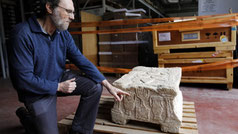
70 AD? Professor Gideon Avni, head of the Archaeological Division in the Israel Antiquities Authority, displays the original Magdala Stone, bearing the seven-branched Menorah (candelabrum) which was discovered in a Galilean synagogue dating to the Second Temple period (50 BC-100 AD), during a press tour at the national treasures storerooms of the Israel Antiquities Authority in Beit Shemesh on March 19, 2017. (AFP Photo Menahem Kahana). TimesofIsrael.com. Source: Link

70-100 CE. Caesarea City coin. Bronze prutah (1.55 gm). These coins are not Jewish coins but merely copies or imitations of Jewish coins and were struck in Caesarea on the initiative of that city's mint. It depicts an imitation of the sacred Jewish menorah, albeit one with 10 or 11 branches. Clearly the object in question is a menorah, and some similar forms are shown in drawings. This coin is part of series was discussed in some detail by H. Hamburger, "Minute coins from Caesarea". Source: Link

82 AD. The Arch of Titus in Rome was constructed by the Emperor Domitian after the death of his older brother Titus to commemorate Titus's victories, including the Siege of Jerusalem. The Jewish–Roman War began 66 AD. The siege ended with the destruction of the Temple (AD 70). According to some sources, the lower part, the base, was created especially for the triumphal procession (see the illustration of 1804). Source: Link1, Link2
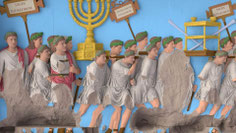
82 AD. Archaeologists Reconstruct How the Arch of Titus Looked – in full colour. When built, the Arch was not a majestic white stone testimony to Rome crushing the Jews, it was a brightly colored monument aggrandizing Vespasian and his dynasty. Haaretz.com. Credit: VIZIN and the Yeshiva Univ. Center for Israel Studies. Source: Link

82 AD. Artistic reproduction. "Interestingly, the depicted Menora shows animals. According to Hebrew tradition this is not done on sacred items. It seems the Menora conquered AD 70 originated from the Hellenistic world and was not original item build at the exodus which took place some 1100 years earlier. According to tradition, the Menora Titus got was given to the temple by king Judas Makadeus in 160 BC. It seems there existed different versions of the relics throughout the ages. Things were stolen or destroyed and replaced." Link1, Link2

1st century. This oil lamp is unusual in several respects. First of all, it is made of stone. Almost all of the thousands of recovered ancient oil lamps are made of clay; stone oil lamps do exist, but they are rare and survive in mere fragments. Unlike clay objects, stone objects are not subject to impurity, so ritual holiness is assured. This oil lamp seems to be much larger and heavier than any other ancient oil lamp ever discovered. It is round and nearly 9 inches in diameter; it weighs nearly 4 pounds. Source: Link

1st century CE. Roman Judean 7-Wick Pottery Terracotta Oil Lamp. Reminiscent of a 7-branched Hebrew menorah, with petal-like motifs radiating from the central filler hole, an upraised pointed handle, and on the base, an impressed petaled flower mirroring the design around the filler hole. Such lamps could hold multiple wicks (made from pieces of linen, flax, or papyrus) and thereby produce numerous flames of light. Size: 4.875" L x 4.75" W (12.4 cm x 12.1 cm). Source: Link
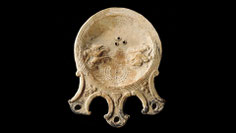
1st century AD (ca.). An early Jewish terracotta oil lamp. Red-slipped, with three voluted nozzles, molded with two figures of Silenus seated upon a donkey on either side of the discus, perhaps also to be interpreted as Balaam and the Ass (Numbers 22:21-35), with a cluster of grapes on one side, and a seven-branched menorah composed of dots toward the nozzles. Size: 9 3/8 in. (23.8 cm) long. Christie's, Sale 1163, Lot 316. Source: Link

1st century. An early Jewish terracotta oil lamp from the Roman period. With a short round nozzle, the discus molded with a seven-branched menorah on a tripod base, flames surmounting each arm, the arms and stem all ridged, a fill hole on either side of the stem, a workshop stamp on the base. Size: 3¼ in. (8.3 cm.) long. Christie's, Sale 1384, Lot 78. Source: Link1, Link2
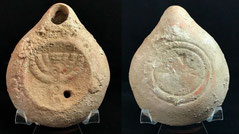
1st century AD (ca.). An early terracotta oil lamp Roman period. With a short round nozzle, the indented discus molded with a seven-branched menorah on a base, circular design on main stem, the arms and stem all ridged, a fill hole on right side of the stem, a workshop stamp on the base, double ring design around base. Size: 2.69 inches in diameter (68.30 mm); 3.30 inches in length (83.70 mm). Source: Link1, Link2

1st to 3rd century CE. A mold-made terracotta oil lamp of a petite composition with a concentric ring base, gently-sloping walls, rounded shoulders, twin fill holes, and a protruding wick spout. Centered within the recessed tondo is a stylized menorah with seven upraised candle-holders in low-relief, its squat base resting on a set of concentric circles. Dimensions: 3.625" L (9.2 cm). LiveAuctioneers 2018, Lot 0040A. Source: Link

1st century AD. A Roman buff pottery oil lamp with a wide filler hole. The shoulder is decorated with three pomegranate fruit to each side. The lamp features a nozzle with a menorah and a short lug handle at the rear. The menorah is where the light appears. Dimensions: 34 grams, 85 mm (3 1/4"). LiveAuctioneers 2017; Lot 0177. Source: Link1, Link2, Link3

1st-3rd century. Ancient Roman Judean Hebrew Terracotta Oil Lamp with Menorah. Material: Terracotta. Provenance: Obtained from an old British collection; Purchased from a private London collector, acquired between 1960-1990. Size: 89 mm; 57.7 grams. Liveauctioneers, Lot 0021. Source: Link

1st Century AD. A Roman ceramic lamp with a Menorah inverted on the concave discus, the spout long with rounded nozzle, handle now lost and a raised disk base. Size: L: 3 ½ in (8.9 cm). LiveAuctioneers. Source: Link
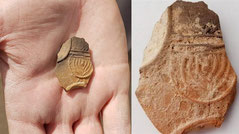
1st century up to 135 AD. Part of an oil lamp decorated with a menorah. In 2019, the remains of a Jewish settlement of the Second Temple period have been discovered in Beer Sheva. On one lamp, a menorah. The fact that it has 9 branches is not unusual. In keeping with the Babylonian Talmud, which said that only the Temple menorah could have 7 branches, Jews making or drawing menorahs would obediently depict anywhere from 8 to 11 branches. Source: Link1, Link2, Link3, Link4
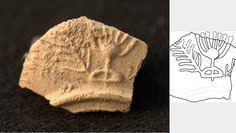
70 to 135 AD? Oil Lamp fragment from the Roman period village of Shikhin in Israel’s Lower Galilee. Bearing images of the lulav and seven-branched menorah. Probably made between 70 and 135 CE, that is, between the end of the Great Revolt and the end of the Bar Kokhba Revolt. Photo by Dror Maayan. Menorah lamp drawing by James R. Strange. Source: Link1, Link2

1st-3rd century AD. Roman Ceramic Fragment with Menorah. A terracotta token with low-relief image of a menorah. 5.3 grams, 36 mm (1 1/4"). From an important central London collection formed since the mid 1960s; thence by descent. LiveAuctioneers, Lot 1652, 2019. Source: Link

1st-2nd century. Messianic menorah. The Messianic Seal of Jerusalem, the base of the menorah and the tail of the Ichthys come together to form the Star of David (Magen David). While the Star of David came into more common use in the Middle Ages, it dates back to the sixth century B.C. as a symbol for the nation of Israel/Judah with David as Israel's greatest king. Source: Link

1st-2nd century. The Messianic Seal of the Jerusalem Church. Suppressed since 135 C.E. by the Orthodox Rabbis - Buried for millennia by the Roman Catholic Church... Resurrected after nearly 2,000 years, from an ancient grotto adjacent to the very first Christian Church on Mount Zion. Source: Link1, Link2, Link3, Link4, Link5

1st-2nd century. Messianic menorah, messianic seal. This early, first century symbol, discovered on Mt. Zion in Jerusalem portrays the menorah, and the Ichthys or 'fish' coming together to form the Star of David. The Ichthys or 'fish' symbol is still a symbol for the Church, which translates into English as "Jesus Christ, Son of God, Savior". Source: Link1, Link2

1st century AD. Jewish tombstone from Phanagoria with the images of the menorah (seven-branched candelabrum), shofar (ram's horn) and Lulav (palm branch). Phanagoria (Ancient Greek: Φαναγόρεια, translit. Phanagóreia) was the largest ancient Greek city on the Taman peninsula, spread over two plateaus along the eastern shore of the Cimmerian Bosporus. Today the site is located at a short distance to the west of Sennoy in Krasnodar Krai, Russia. Source: Link

1st-2nd century. Tomb number 163d in Hierapolis, Turkey. Although actual synagogues have not been found a variety of menorahs have been found engraved on tombs, a sarcophagus, and a column indicating a Jewish presence in the area. The important city of Hierapolis is mentioned in the NT (Col 4:12-13). Source: Link

1st-2nd century. Hierapolis, Turkey. Marble lid of a Jewish sarcophagus with a menorah and a faint Greek inscription. Same source as above: http://holylandphotos.org. Source: Link

1st century. One of the highlights of the 2017 exhibition from the Vatican Museums and the of Rome's Jewish Museum is recently discovered bas relief from a 1st century Galilee synagogue. Source: Link

1st-3rd century. Fragment of a Roman Period Lead Sarcophagus Depicting a Menorah. The vine and grapes are a symbol of fertility and blessing from the lord. Thus the iconography of this sarcophagus clearly identifies the deceased individual who was once held within its confines as a pious Jew who was blessed by the lord in life, as he no doubt also was in death. Origin: Jerusalem, Israel. Dimensions: 7.8" (19.8cm) high x 8" (20.3cm) wide. Location: Great Britain. Source: Link1, Link2, Link3

1st-3rd century. Fragment of a Roman Period Lead Sarcophagus, reveals that Judaism continued to thrive in Ancient Israel despite the brutal repression of the Roman Occupation. A circular band that once framed the central image is still visible in the bottom right corner. Inside this circle, one sees the image of a menorah surmounted by two bunches of grapes. Location: Great Britain. Source: Link1, Link, Link3

1st-4th century (?). A lead disc with Menorah decoration. Size: 8.5ins diameter. LiveAuctioneers 2019, Lot 1602. Source: Link

1st-2nd century. Ancient glass seal depicting a menorah. Origin: Israel. Source: Link

1st century. Ancient pendant made of agate. Gem with circular shape and brown tones with streaks. Place of Origin: Jerusalem. Obverse with seven-branched candelabra decoration. The reverse shows various notches. The piece has a small hole that crosses it from the upper area to the lower one. Dimensions: Major axis = 3.60 cm; Minor axis = 3.20 cm; Thickness = 0.90 cm. Foto: Rebeca García Merino. Museum Sefardi, Spain. CERES. Source: Link

1st-4th century. Ancient Roman Glass & Lead Beads with Menorahs. Three beads depicting menorahs from ancient Rome, including a translucent blue-green glass pendant depicting a seven-lamp (six branches plus the central one) menorah upon a depression on its round form with an integral glass suspension loop, another of glass that has darkened, and a third of grey lead. Liveauctioneers, Lot 0019. Source: Link

1st century AD. Lead seal with menorah. Pb 14mm (2.43 gm). Antiquainc.com Source: Link

1st-2nd century. Bronze seal, Lost wax casting technique. This type of bronze seals, or signacula, are composed of two parts. On the one hand, a plate with an engraved text and on the other a ring that can be of rectangular, polygonal or circular section, and with a diameter that varies from one specimen to another. Next to a name the Jewish symbol of the menorah appears. Place of Origin: Southern Italy. Museo Arqueológico Nacional, Spain. Foto: Gonzalo Cases Ortega. Source: Link
More Pictures of Ancient and New Menorahs:
Note: It's nice to see the menorah pictures. However, according to the Bible Jesus (Hebrew Yeshua) is the true spiritual meaning behind the physical Menorah. He is the true and eternal spiritual light: "I am the light of the world. Whoever follows me will never walk in darkness, but will have the light of life" (John 8:12). The menorah also symbolizes the Tree of Life, because Jesus is the way to life: "I am the way, and the truth, and the life. No one comes to the Father except through me" (John 14:6). Jesus' Word and the Bible are the light in this world. "Your word is a lamp to my feet and a light to my path" (Ps 119:105 and John 1:1-17).
Copyright info and disclaimer: All content and all photos from ancient and new menorahs provided on this website is for informational purposes only. It is not allowed to publish photos from this website on other websites or printed literature. Please always use only the original sources of the photos. We make no representations as to the accuracy or completeness of any information on this website or found by following any link on this website. We will not be liable for any errors or omissions in this information. We will not be liable for any losses, injuries, or damages from the display or use of this information. We can not guarantee the validity and accuracy of the information, please always check the original source. The opinions expressed from other website owners and those providing comments are theirs alone, and do not reflect the opinions of us.













